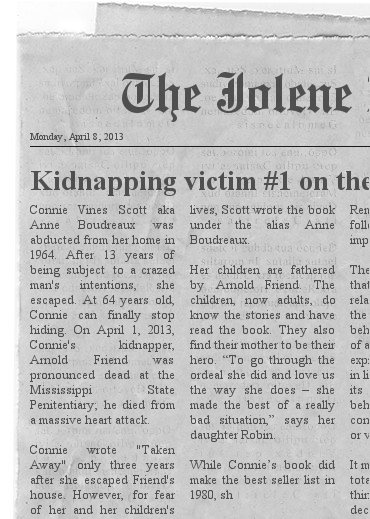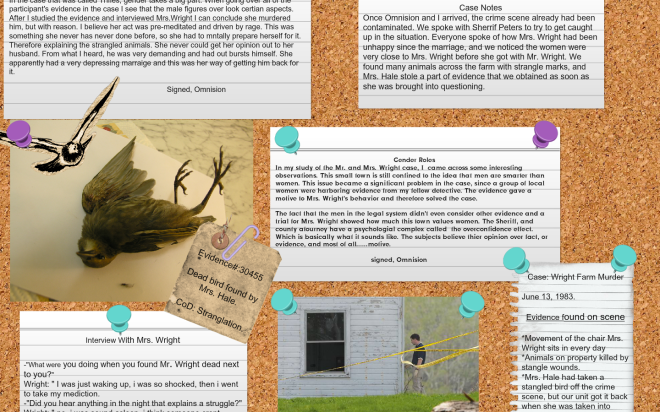This week in the Games-Based Learning MOOC we’ve been discussing Alternate Reality Games (ARG’s) and how to design them, especially in terms of building a narrative that will engage the players and help them become immersed in the game. For me, the most challenging aspect of designing and building an ARG is how to establish the “this is not a game” mentality (TINAG). In discussing both narrative and TINAG, I couldn’t help but think of Samuel Taylor Coleridge’s theory of the willing suspension of disbelief. In describing his contributions to his and Wordsworth’s seminal collection of poetry, Lyrical Ballads, Coleridge wrote:
It was agreed, that my endeavours should be directed to persons and characters supernatural, or at least romantic, yet so as to transfer from our inward nature a human interest and a semblance of truth sufficient to procure for these shadows of imagination that willing suspension of disbelief for the moment, which constitutes poetic faith.
The result of Coleridge’s efforts is the greatest piece of supernatural poetry ever written: The Rime of the Ancient Mariner. There are two essential components to Coleridge’s method: human interest and a semblance of truth; we see these two aspects of Coleridge’s theory at work in The Rime and it is, I believe, an excellent text for game designers to study in order to better understand both. So, the two questions that I’ve been considering this week as I continue to work on designing my Interactive Fiction syllabus and how I might integrate AR into some of my other classes is how to ensure that my narratives integrate both human interest and a semblance of truth. A great source of inspiration for me has been a TED Talk that was part of our GBL course work this week; it is the story of teacher John Hunter and the World Peace Game that he has his 4th graders play.
Hunter’s World Peace Game is the perfect example of an ARG that addresses both of Coleridge’s requirements for a willing suspension of disbelief. You can tell from watching and listening to Hunter’s students that they have willingly accepted the TINAG premise because they both value the importance of the humanistic issues embedded within the game and they are, through immersive role-play, creating a semblance of truth.
In my own game design, the human interest component is not as much a challenge as how to create a semblance of truth. For this, my own FYC II students have provided some very good examples. As mentioned in my last post, this class is using immersive role-play to analyze and write about the short stories and plays they’re reading, which they have, as part of their role-play, treated as real events. Students have been working in role-based guilds all term, but for the final project, I asked them to partner with someone from a different guild and work together to create a multimodal piece that demonstrates their characters’ combined analysis of one of the texts we have covered. In doing so, the students have utilized various methods to imbue their work with a sense of realism.
Social Media
One group decided to address Edward Albee’s The Zoo Story, which involves an encounter between two strangers during which one, Jerry, seems to force the other, Peter, into helping him commit assisted suicide. Because Jerry is dead, the students recognized that they would need a way to investigate his motives. They decided to create a Facebook page for Jerry; using clues from the text, they created a page that included a profile pic, status updates, and quotations that indicated that Jerry was becoming increasingly depressed due to feelings of social inadequacy and isolation.

Because social media use is so ubiquitous, the students knew that, however isolated and disconnected Jerry might be in real life, he would more than likely use social media as a way to try to connect to people and as a venue for expressing his feelings.
When creating an ARG, social media is an excellent way to add a veneer of reality. Almost everyone has either a Facebook or Twitter account (or both) and most businesses and organizations also use one or both of these forms of social media for networking with other companies/groups and advertising to and connecting with potential and existing customers/clients. Social media embodies verisimilitude not only because of its popularity, but because it offers the ability to release content in real time, thus providing a sense of immediacy; social media sites are, by nature, frequently updated and content is organized in reverse chronological order. Because of this, social media is also a way to add ambiguity to your narrative (ambiguity being one of the seven ways that games reward the brain); by not having all information available immediately but releasing it gradually over the life of the game, players are more likely to become invested in remaining in the game in order to access the missing information and are more likely to experience the feeling of TINAG (because real life is ambiguous and full of unknown variables).
Blogs
Another group, also addressing The Zoo Story, integrated one of the character’s blog into their project, using it as evidence in their analysis (the premise they created is quite complex and involves a Dr. Who-like time-traveling blogger who uses virtual reality to experience events from the past from whatever point of view he wishes; during the events of The Zoo Story, he chooses to inhabit Jerry and, in the process, becomes entangled with his identity, bringing it back with him and recreating Jerry’s actions in his own time so that the other students’ investigation must solve both murders). Again, the students recognized that many people are now living their lives virtually via the internet and blogs are one of the most popular ways in which they are doing so (at the beginning of 2011, there were over 156 million public blogs and an untold number of private ones).
When creating an ARG, blogs are a good way to bring in the perspective of various characters. One example ARG that we looked at this week in the MOOC, Exocog, uses a blog in order to provide insights from the main character, Sarah. Like social media, blogs are frequently updated, affording a chance to release information over the life of the game and create a feeling of immediacy.
Websites
One student who ended up having to work independently decided to build on a previous project she had completed during the term for Joyce Carol Oates’s short story “Where Are You Going, Where Have You Been,” which involves a teenage girl who is kidnapped by an older man. For her original project, the student, who had taken on the role of a criminal defense investigator, had filled in a real missing person’s report for the kidnapped girl, Connie. For her final project, the student created a premise in which Connie eventually escapes her abductor 13 years later, writes a best-selling book about her experiences, and starts a non-profit called Safe Zone, for which the student created a website. Again, websites are a common method for organizations and companies to provide information about their work to the public. Exocog also makes use of websites for providing clues and information to players. There are several tools for building a free website, two of my favorites being Google Sites and Weebly. While websites typically are more static than blogs, they are sometimes updated, so you can choose either option.
Web 2.o Tools
There are several other web 2.0 tools that can be used to add realistic elements to an ARG, several of which were mentioned in my last post on DIY mystery games. My students this term have utilized two of these tools in interesting ways. As part of her final project on the escaped kidnap victim, Connie, the criminal defense investigator used Fodey to create a newspaper clipping in order to introduce the premise behind Connie’s re-appearance.

A second tool that students made use of to bring a sense of truth to their projects is Glogster. One team, a cold-case detective and a forensic psychologist, used Glogster to create an evidence board for the play Trifles by Susan Glaspell.

These are just two examples of how web 2.o tools can be used to create the kinds of media you might find in real-life contexts within the game narrative. While you can’t have players discover a real newspaper article (or maybe you can?) or stumble upon a real evidence board in a real squad room, you can create virtual versions to embed within the game. Just remember that in order to maintain the TINAG-ness you’ll need to have players discover them under realistic circumstances (perhaps one of the detectives takes a photo of the evidence board and posts it to his blog or a character “pins” the newspaper clipping to their Pinterest board).
While the tools that I have focused on are all internet-based, don’t forget that you can integrate real-world media into your ARG, as well. If you can do so, integrating some location-based experiences into your narrative will increase player engagement, especially for students who are kinesthetic learners. Cemeteries and libraries are just two places that are chock-full of real-world media that lend themselves to ARG’s. The goal is to integrate as many different kinds of experiences and media as you can, always keeping Coleridge’s two narrative ideals of human interest and verisimilitude in mind.



